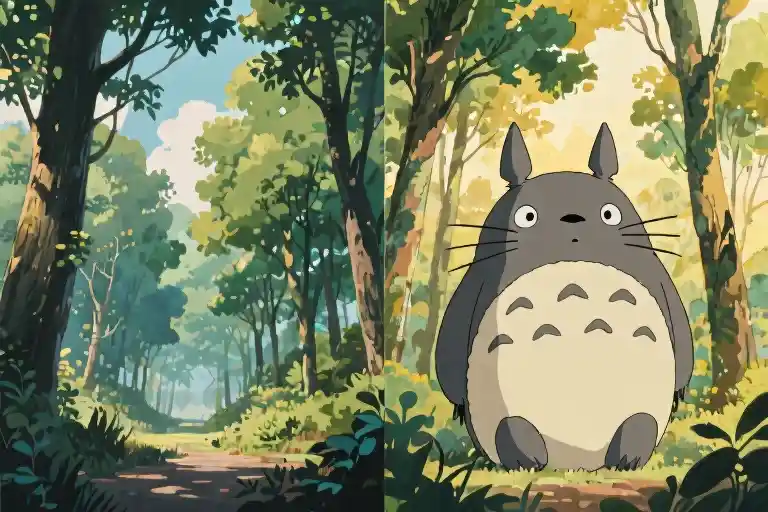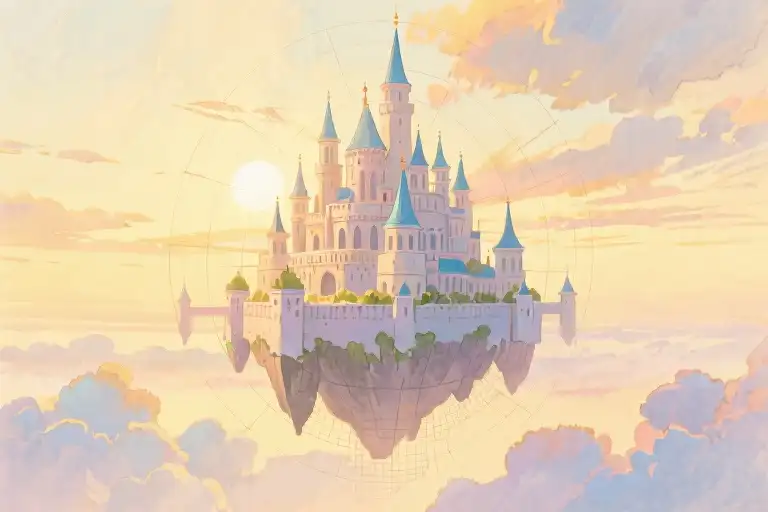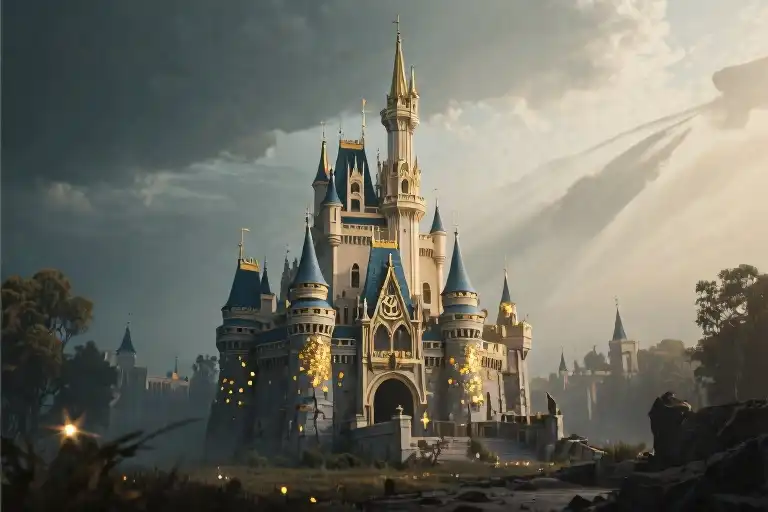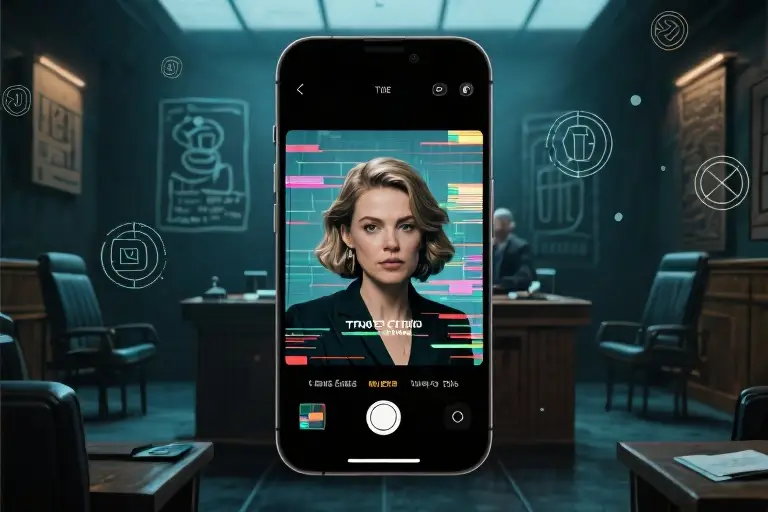The notification popped up on my phone during lunch break – a friend had tagged me in an Instagram story. I tapped absentmindedly, expecting another brunch photo or puppy video. What loaded instead made me freeze mid-bite: there was my college roommate Jessica, but transformed into a character straight out of a Studio Ghibli film. Her round cheeks now had that soft pastel glow, her messy bun replaced with those signature wind-swept anime strands, even the café background morphed into something resembling the flower fields from Howl’s Moving Castle. The caption read: “Ghiblified myself! 😍”
Like most 90s kids raised on My Neighbor Totoro VHS tapes, I reacted instantly: “How cute!” Before thinking, my thumb had already hit the “Try This Filter” button. Three attempts later (because apparently AI struggles with my curly hair), I stared at my phone screen – there I was, pixel-perfect in that unmistakable Ghibli aesthetic, complete with oversized expressive eyes and watercolor-textured skin. The image got 47 likes in 20 minutes, my most engaged post in months.
That’s when the unease crept in. Between replying to comments with heart emojis, I kept zooming into the details: the way the algorithm had replicated the delicate shading under my chin, the almost-too-accurate imitation of background foliage that looked plucked from Princess Mononoke. It felt… wrong. Not legally wrong, but emotionally dishonest, like I’d taken someone else’s childhood memories and run them through a photocopier. My fingers hovered over the delete button as I whispered to my empty apartment: “Why does this feel like cheating Miyazaki?”
Perhaps you’ve had this moment too – that split second of delight followed by quiet discomfort when technology crosses an invisible line. What begins as playful fun (“Look, I’m an anime character!”) suddenly morphs into something more complicated when we realize what’s being replicated isn’t just a visual style, but four decades of painstaking human creativity. Studio Ghibli’s films aren’t merely animations; they’re hand-painted time capsules of cultural memory. Every frame of Spirited Away contains more deliberate brushstrokes than most of us will make in a lifetime – and now an algorithm can approximate it in 3.7 seconds.
This tension between technological wonder and artistic integrity defines our current cultural moment. As AI tools democratize creative expression (who hasn’t giggled at turning their cat into a Renaissance painting?), they also force uncomfortable questions about authenticity. For those of us who grew up waiting years between Ghibli releases, each film arriving like a carefully wrapped gift from Japan, the instant gratification of AI-generated nostalgia feels… hollow. Like eating cotton candy when you expected homemade mochi – sweet at first bite, but leaving no lasting nourishment.
My guilt, I’d later realize, stemmed from recognizing something fundamental: Ghibli’s magic was never about the surface aesthetics. What makes Totoro more than a cartoon character, what makes Chihiro’s journey more than a plotline, is the palpable human intention behind every creative decision. You can teach an algorithm to copy the cel-shaded outlines and saturated skies, but how does it replicate the way Miyazaki paces scenes to match childhood perception of time? Or the specific weight of rain in Ponyo that took animators months to perfect? These aren’t technical challenges – they’re questions of soul.
And so I left the post up, but added a caption I hadn’t planned: “AI-made with love (and guilt) – nothing beats the real Ghibli magic.” The first reply came from a film student in Kyoto: “Exactly. The machines may learn the style, but can they cry while drawing?”
When AI Meets Totoro: The Digital Gold Rush
Scrolling through Instagram last Tuesday, I paused at a friend’s post—her profile picture transformed into a Ghibli-style watercolor portrait, complete with those signature fluffy clouds and wide-eyed wonder. Within hours, my feed became a parade of familiar faces reimagined as Studio Ghibli characters. By Friday, even my tech-averse aunt had “Ghiblified” her cat.
The Algorithm Behind the Magic
These AI-generated images don’t just mimic Ghibli’s aesthetic—they reverse-engineer its DNA. The tools (often free browser-based apps) analyze thousands of frames from films like Spirited Away and My Neighbor Totoro, learning to replicate:
- Color palettes: Those milky aquamarine skies and earthy greens
- Line work: Delicate pencil-like strokes with intentional imperfections
- Character proportions: Oversized eyes and soft, rounded features
Yet there’s a catch—the AI only understands patterns, not purpose. It copies how Ghibli artists draw raindrops but misses why they fall so heavily in Princess Mononoke‘s forest scenes.
Viral, But at What Cost?
Take my friend Marco’s experience: he uploaded 15 vacation photos to a popular AI Ghibli filter last month. The results were charming—his Rome trip photos now looked like stills from Porco Rosso. His post got 2.3K likes, but later he confessed: “It felt like wearing a designer knockoff. Fun, but faintly wrong.”
This sentiment echoes across creative communities. A 2023 survey by Digital Art Alliance found:
- 72% of respondents used AI art tools
- 61% experienced “style guilt” when replicating specific artists’ work
- Only 34% credited the original inspiration source
Why This Matters Now
We’re at a cultural crossroads where:
- Accessibility clashes with authenticity—Anyone can now create Ghibli-esque art, but should they?
- Nostalgia fuels normalization—The very love for Ghibli makes us overlook ethical questions
- Speed undermines substance—What took artists years to perfect gets reduced to algorithmic presets
As the comments on Marco’s post proved (“So much better than the original photos!”), we risk conflating imitation with improvement. Next time you see those AI-generated Totoro lookalikes, ask yourself: Is this celebrating Ghibli, or cannibalizing its legacy?
The Ghibli Magic: Why AI Always Falls Short
There’s an unmistakable alchemy to Studio Ghibli films that transcends technical perfection. While AI can replicate the surface aesthetics – the rounded character designs, pastel color palettes, and floating dust particles – it fundamentally misses what makes these animations breathe with life.
The Handcrafted Imperfections That Matter
Every frame in a Ghibli production carries the weight of human intention. The slight wobble in hand-drawn lines during emotional scenes, the deliberate unevenness of watercolor washes, and the strategic placement of empty space all serve the storytelling. In Spirited Away, notice how Chihiro’s hair strands become messier as her journey progresses – a visual metaphor no algorithm would conceive.
A recent comparison between AI-generated Ghibli-style images and original frames from My Neighbor Totoro revealed critical differences:
| Element | AI Version | Ghibli Original |
|---|---|---|
| Rain Animation | Uniform digital droplets | Varied brushstroke textures |
| Character Blinks | Mechanically timed | Emotionally paced |
| Background Depth | Flat layers | Atmospheric perspective |
Nature as a Character
Ghibli’s environmental storytelling presents another hurdle for AI. The studio doesn’t merely depict nature; it imbues landscapes with personality. The way wind interacts with grass in Princess Mononoke isn’t physics-perfect animation – it’s how the animators felt the wind should move to convey tension. As Miyazaki once remarked during a documentary: “Our rain isn’t just water falling. It contains memories of all the rains we’ve experienced.”
The Narrative in Every Brushstroke
What truly separates Ghibli art from AI imitations is the embedded narrative consciousness. Background artists at the studio famously receive full script access, allowing them to infuse environments with foreshadowing. That innocuous teapot in the first act? It might become pivotal later. AI generators lack this intentionality, creating visually pleasant but narratively hollow compositions.
Lead animator Takeshi Honda summarized this distinction perfectly: “We don’t draw what things look like; we draw what they mean.” This explains why AI-generated Ghibli art often feels unsettlingly “off” – it replicates the vocabulary but not the poetry.
The Time Factor
Consider the production timeline:
- AI Generation: Seconds to minutes
- Ghibli Frame: 1-2 days per animator (12 frames = 1 second of film)
This temporal investment manifests in subtle details – the way light filters through leaves in The Wind Rises required months of observational sketches. No dataset can compensate for this lived experience.
For those who grew up with these films, the difference is visceral. As one fan described it: “AI Ghibli feels like receiving a beautifully wrapped empty box.” The exterior charm exists, but the emotional weight – built through decades of artistic devotion – remains conspicuously absent.
The Introvert’s Dilemma: Why “Perfect” AI Art Feels Wrong
That nagging discomfort when scrolling through AI-generated Ghibli art isn’t just nostalgia playing tricks. For introverts especially, there’s something profoundly unsettling about these technically flawless imitations. Like biting into a 3D-printed wagashi – visually perfect, yet completely hollow where the soul should be.
The Psychology Behind Our Discomfort
Research from the Journal of Personality and Social Psychology shows introverts have heightened sensitivity to authenticity. We’re wired to:
- Seek deeper meaning in human creations
- Value intentional imperfections (like pencil strokes in storyboards)
- Distrust surface-level perfection that lacks context
When AI replicates Ghibli’s visual style without the forty years of cultural context behind Spirited Away‘s bathhouse or Princess Mononoke‘s forest spirits, our brains register the dissonance instantly. The algorithm may copy the brushstrokes, but it can’t replicate:
- The way Miyazaki’s pacifism shapes every frame
- The weight of childhood memories in Totoro’s fur
- The cultural significance of Kamaji’s six arms
That “Something’s Off” Feeling
Remember your first encounter with AI Ghibli art? The initial delight (“How magical!”) followed by creeping unease? That’s your introvert brain detecting:
- Emotional Flatness: No amount of cherry blossoms can compensate for missing the animator’s hand that drew each petal with purpose
- Context Collapse: A Ghibli-style landscape generated for someone’s vacation photo carries none of the environmental themes central to the studio’s work
- The Uncanny Valley of Art: Close enough to recognize, but far enough to feel disturbingly hollow
Like hearing a loved one’s voice in a robocall, the imitation triggers instinctive distrust. For introverts who often prefer:
- Handwritten letters over templated emails
- Small talk-free gatherings
- Album listening over algorithm-generated playlists
…AI art can feel like the ultimate superficial interaction – beautiful, but impossible to form a genuine connection with.
The Plastic Cherry Blossom Paradox
Consider two scenarios:
Scenario A: You receive a mass-produced Studio Ghibli poster from an online store
Scenario B: A friend sketches you a Totoro with slightly wobbly lines
Most introverts would treasure B infinitely more, because:
- The imperfections prove human effort
- The act of creation carries emotional weight
- It represents a shared understanding between two people
AI-generated Ghibli art exists in a strange middle ground – more polished than amateur fan art, yet less meaningful than either professional work or personal creations. Like plastic cherry blossoms decorating a corporate lobby: technically impressive, emotionally sterile.
This explains why many introverts report feeling:
- Physically tired after viewing too much AI art
- Yearning for “real” Ghibli works afterward
- Uncomfortable sharing AI-generated images despite their visual appeal
Our brains expend extra energy analyzing what’s missing from these technically perfect imitations – the very thing that makes Ghibli films so rewatchable lies in their lovingly crafted imperfections.
Navigating the AI Art Flood
For introverts overwhelmed by the surge of AI Ghibli content:
- Curate Your Feeds: Mute tags like #AIGhibli and follow traditional animators
- Seek the Human Touch: Support artists who post process videos showing their hand-drawn work
- Embrace Imperfections: Value fan art with visible pencil marks over algorithmically smoothed images
- Dig Deeper: When you find authentic Ghibli-style art, read about the artist’s inspiration
True to our nature, we don’t have to reject technology outright – but we can consciously choose where to direct our limited social energy, even in digital spaces. The next time an AI Ghibli filter tempts you, ask: “Will this leave me feeling nourished or empty?” Your introvert instincts already know the answer.
Loving Ghibli the Right Way: From Consumption to Appreciation
The guilt I felt after creating that AI-generated Ghibli-style image lingered longer than expected. It wasn’t just about violating some unspoken artistic code – it was realizing I’d become part of a system that risks diluting what makes Studio Ghibli’s work truly magical. For those of us who grew up with Totoro’s gentle paws and Chihiro’s determined eyes, there are better ways to celebrate this legacy that honor the artists behind it.
Curated Purchases That Support the Magic
- Official Studio Ghibli Merchandise
- The Ghibli Museum’s online store offers everything from hand-painted cels (starting at $200) to $30 plush toys, with profits directly supporting the studio
- Look for the gold holographic seal – counterfeit Ghibli items flood marketplaces like Etsy
- Limited Edition Art Books
- “The Art of Spirited Away” contains 216 pages of original watercolor concept art ($45 on Amazon)
- These publications employ traditional Japanese bookbinding techniques – something AI can’t replicate
- Theater Experience Revival
- Fathom Events frequently screens restored 35mm prints in US theaters ($12/ticket)
- 82% of animation professionals say theatrical viewings fund preservation efforts
Ethical AI Engagement Guidelines
When using AI tools to create Ghibli-inspired art:
- Always label as “AI tribute” not “original work”
- Credit prompts that reference specific Ghibli artists (e.g. “inspired by Kazuo Oga’s forest designs”)
- Avoid monetization – these derivatives violate Studio Ghibli’s famously strict copyright policies
Beyond Consumerism: Active Appreciation
- Sketchbook Challenges
- Try recreating frames using traditional media – you’ll gain new respect for the 150,000+ hand-painted cels in “Princess Mononoke”
- Behind-the-Scenes Documentaries
- NHK’s “10 Years with Hayao Miyazaki” reveals the 4-year process behind “Ponyo”
- Support Living Artists
- Platforms like Kickstarter help animators like Naoko Yamada (“Liz and the Blue Bird”) fund independent projects
Resources That Keep the Spirit Alive
- Ghibli Museum Library (ghibli-museum.jp) – Digital archives of production notes
- The Ghibli Blog – Interviews with retired background painters
- Tokyo’s Kichijoji District – Visit real-life locations that inspired “Whisper of the Heart”
That nostalgic ache you feel when hearing Joe Hisaishi’s piano themes? That’s what we’re preserving. Every official DVD purchase, museum ticket, and art book keeps this delicate ecosystem alive in ways no algorithm can duplicate. The choice isn’t between technology and tradition – it’s about using tools responsibly so future generations can still experience that authentic Ghibli magic.
When Technology Meets Nostalgia: A Love Letter to Ghibli’s Authenticity
There’s a particular scent of rain-soaked earth in My Neighbor Totoro that no AI could ever replicate. That moment when Mei first tumbles into Totoro’s belly—the way her laughter bounces through the forest canopy—holds more emotional truth than a thousand algorithmically perfect frames.
The Uncopyable Magic
What makes Studio Ghibli films endure isn’t just their visual beauty (though the watercolor skies of Porco Rosso could make a grown artist weep), but the human imperfections woven into every frame:
- The slightly uneven brushstrokes in Spirited Away’s bathhouse tiles
- The deliberate silence between Chihiro’s sobs
- How the wind actually moves Kiki’s dress, not just her broom
These aren’t technical achievements—they’re revelations of a creator’s soul. As Hayao Miyazaki once scribbled in a production sketch margin: “Make this cloud look tired.” No dataset can comprehend such instructions.
Our Shared Dilemma
So when you ask “Would I generate my own Ghibli dream?”—I’ll confess something. Last Tuesday, I almost did. The prompt box was open: “Whimsical forest scene, Ghibli-style…” Then I remembered the blisters on animator’s fingers from documentary The Kingdom of Dreams and Madness.
Here’s what we can do instead:
- Rewatch Responsibly: Purchase films through Ghibli’s official store—those Blu-ray extras fund future art
- Celebrate the Humans: Follow @ghibli_artbooks on Instagram for never-before-seen hand-drawn layouts
- Create with Consciousness: If using AI tools, label clearly as “Inspired by” not “Ghibli-style”
Keep the Conversation Alive
What does authentic art mean to you in this AI era? Have you found ways to honor original creators while embracing new tools? Drop your thoughts below—let’s build this discussion like Kiki building her delivery service: one honest brick at a time.
P.S. That Totoro plush on your shelf? The stitching’s uneven where his grin meets his belly. That’s not a defect—it’s a signature.





